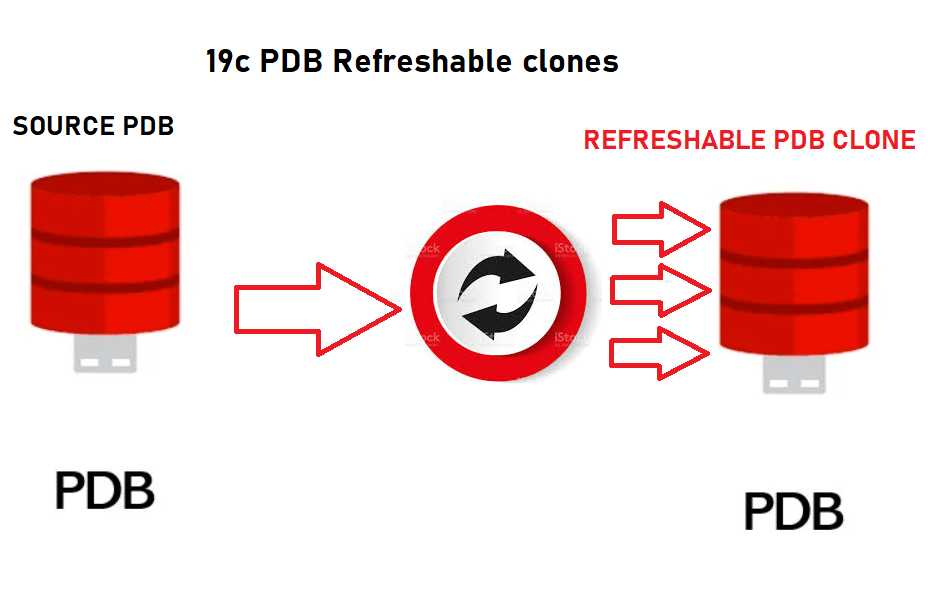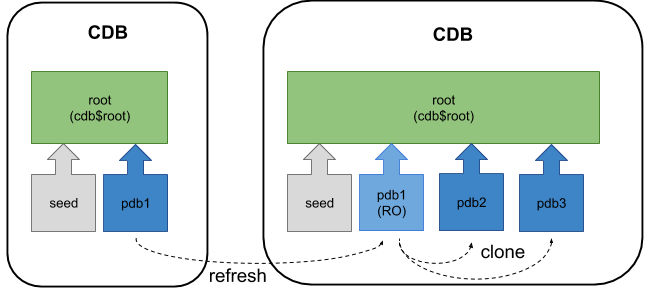OCI FortiGate HA Cluster – Reference Architecture: Code Review and Fixes
Introduction OCI Quick Start repositories on GitHub are collections of Terraform scripts and configurations provided by Oracle. These repositories ... Read More
Learn more about why Eclipsys has been named the 2023 Best Workplaces in Technology and Ontario, Certified as a Great Place to Work in Canada and named Canada’s Top SME Employer!
Learn more!
Besides the long-term release benefits, upgrading to a multitenant 19c Database will completely ease the way test environments are refreshed from production servers. Say goodbye to complex & lengthy RMAN (Recovery Manager) duplicate scripts and hello to remote cloning. Even better with refreshable clones, production data is now automatically updated. Many blogs were written about it like the one from Tim Hall, Franck Pachot(Poor man’s standby), or Oracle ACE peer Diana Robete. But I still found something to add, as I used Oracle scheduler to automate the refreshes unlike the default available option (EVERY X Minutes).
SNAPSHOT clause or automatically using ‘EVERY interval’.

Prerequisites
Similar to those of a hot, remote clone, here are the most common (19c) prerequisites:
Refresh Considerations
This scenario assumes DB file parameters are not defined in the target environment. OS: Windows
NAME VALUE
-------------------- --------------------
db_file_name_convert
pdb_file_name_convert
db_create_file_dest
1- Create a common user in the source CDB with the required privileges where source PDB is “PSPROD”
SQL> Create user c##psprod_clone identified by welcome1 container=all; SQL> Grant create session, create pluggable database to c##psprod_clone container=all;
2- Create a database link at the Target CDB using source TNS alias ‘SourceCDB’
SQL> create database link psprod_clone_link connect to c##psprod_clone
identified by welcome1 using 'SourceCDB';
3- Create a refreshable PDB clone using a manual refresh, plus a few automatic refresh syntax examples.
-- Manual refresh mode. CREATE PLUGGABLE DATABASE PSPDB_RO FROM PSPROD@psprod_clone_link file_name_convert=('D:\ORACLE\DATA\','K:\ORACLE\CDB\PSPDB_RO\DATA\', 'H:\ORACLE\TEMP\','K:\ORACLE\PSPDB_RO\TEMP\') REFRESH MODE MANUAL; -- Automatically refresh every 60 minutes. CREATE PLUGGABLE DATABASE PSPDB_RO FROM PSPROD@psprod_clone_link REFRESH MODE EVERY 60 MINUTES; -- Non-refreshable PDB. -- Both below commands are functionally equivalent. CREATE PLUGGABLE DATABASE PSPDB_RO FROM PSPROD@psprod_clone_link REFRESH MODE NONE; CREATE PLUGGABLE DATABASE PSPDB_RO FROM PSPROD@psprod_clone_link;
4- Perform a manual refresh. The syntax works for Post 12.2 from the root container
SQL> CONN / AS SYSDBA
ALTER PLUGGABLE DATABASE PSPDB_ro CLOSE IMMEDIATE;
ALTER PLUGGABLE DATABASE PSPDB_ro REFRESH;
ALTER PLUGGABLE DATABASE PSPDB_ro OPEN READ ONLY;
5- Check the last refresh time and SCN
SQL> SELECT last_refresh_scn, cast(scn_to_timestamp(last_refresh_scn) as date) refresh_Time FROM dba_pdbs WHERE pdb_name = 'PSPDB_RO' ; LAST_REFRESH_SCN REFRESH_TIME ---------------- -------------------- 17635452014 17-Dec-2021 16:48:17
1- Create The refresh procedure
CREATE OR REPLACE PROCEDURE sys.psprod_refresh
AS BEGIN
EXECUTE IMMEDIATE 'ALTER PLUGGABLE DATABASE PSPDB_RO CLOSE IMMEDIATE';
EXECUTE IMMEDIATE 'ALTER PLUGGABLE DATABASE PSPDB_RO REFRESH';
EXECUTE IMMEDIATE 'ALTER PLUGGABLE DATABASE PSPDB_RO OPEN READ ONLY';
END;
/
2- Create the refresh JOB
BEGIN DBMS_SCHEDULER.CREATE_JOB ( job_name => 'PSPROD_REFRESH_JOB', job_type => 'STORED_PROCEDURE', job_action => 'sys.psprod_refresh', repeat_interval => 'freq=daily;byday=mon,tue,wed,thu,fri;BYHOUR=4; BYMINUTE=1', auto_drop => FALSE, enabled => TRUE, comments => 'Automatic refresh of the prod PDB clone'); END; / SQL>@check_job PSPROD_REFRESH_JOB JOB_NAME REPEAT_INTERVAL ------------------ -------------------------------------------------------- PSPROD_REFRESH_JOB freq=daily;byday=mon,tue,wed,thu,fri;BYHOUR=4; BYMINUTE
You can see that File_name_convert works the same when creating a clone from a refreshable one
SQL> CREATE PLUGGABLE DATABASE PSDEV01 FROM PSPDB_RO
File_Name_convert=('K:\ORACLE\CDB\PSPDB_RO\DATA\','I:\ORACLE\CDB\PSDEV01\DATA\',
'K:\ORACLE\CDB\PSPDB_RO\TEMP\','I:\ORACLE\CDB\PSDEV01\TEMP\');
This was an example of how to automate the refresh of a PDB clone using a DBMS scheduler job that gives better control of the frequency, instead of relying on the minutely refresh. Handy if you don’t like keeping an automatic refresh every X minutes and rather have it run once a day like a backup to avoid any unexpected maintenance.
Note: If you have the ORA-65345 error, “cannot refresh pluggable database”. That means remote archive logs have been wiped from the source server and refresh should be adjusted to match the source backup retention.
Introduction OCI Quick Start repositories on GitHub are collections of Terraform scripts and configurations provided by Oracle. These repositories ... Read More
Introduction So far, I have used Oracle AutoUpgrade, many times in 3 different OS’. Yet the more you think you’ve seen it all and reached the ... Read More